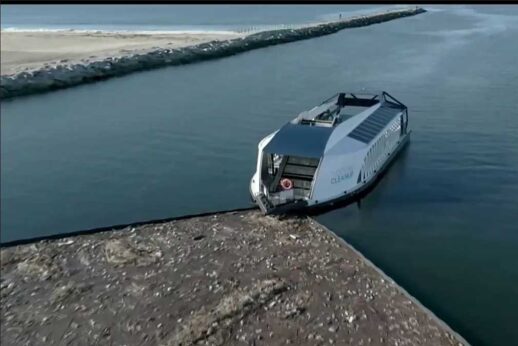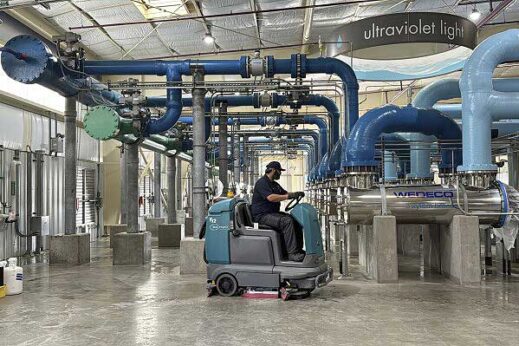
LOS ANGELES -What happens in a California congressional race and other local actions won’t stay in California. A few congressional races alone will have a huge impact on working-class people’s everyday lives here and across the country.
The congressional race in California’s 27th district, for example, is a battle between two distinct visions for the future. On the one hand, working-class voters are attempting to use that fight to build power and on the other hand, corporations are using it to continue and expand monopoly power over people’s lives.
In the high-stakes battle, voters face a choice between the incumbent, MAGA Trump Republican Mike Garcia, and Democrat George Whitesides, former NASA Chief of Staff for the Obama administration.
Labor unions and environmental advocates seek to break the Republican stronghold on the district and therefore weaken that party’s hold on the House nationally through a coalition of multiple interests with shared visions of a more just and sustainable future. They aim to flip the seat as part of a broader strategy to gain a Democratic majority in the House of Representatives.
Located in north Los Angeles County, District 27 is home to a significant Latino population and includes the cities of Lancaster, Palmdale, and Santa Clarita. The area’s economy relies heavily on Edwards Air Force Base and several other major government and private aerospace development facilities including Virgin Galactic, Northrop Grumman, Boeing, and Lockheed Martin.
These industries’ profit-driven pollution creates a harsh environmental reality for the workers who live in the district. A just transition to clean energy and the protection of the environment from pollution are key issues affecting the working-class residents of the district.
Climate denial vs. science
In the months leading up to the election, environmentalists have directed their energy toward fighting against major polluters and winning greater climate victories such as increased investment in a green economy and improved environmental regulations.
Mike Young is the Senior Political and Organizing Director for California Environmental Voters, which for more than 50 years has been working together with the public to build the political will to solve the climate crisis.
“We’ve long recognized that we have the solutions. We know how to build clean technology. We know how to reduce our emissions. We know how to transition the world over. We’re just not doing it,” Young said.
District 27, where California Environmental Voters has long been engaged, is known as a public lands district. Public lands are portions of land and water that are owned by the public and managed by the U.S. Department of the Interior’s Bureau of Land Management.
Young noted that District 27, a region with desert lands and the San Gabriel mountains, is “a place that is definitely feeling the effects of climate change.” Young explained that extreme heat plagues the region and that there are not many options for transport apart from long commuter miles.
Despite these intensifying environmental challenges, the district has a history of leaders who refuse to recognize reality, with MAGA Republican and outspoken climate denier Mike Garcia having served since 2020 as the district’s congressional representative. The League of Conservation Voters rates Garcia at only eight percent for 2023 on their LCV scorecard.
Young told People’s World, “It’s bad enough if you’re not interested in dealing with the problem, but it’s even worse if you deny that there’s a problem at all.”
This year, District 27 has a chance to elect new leadership. Garcia’s opponent is George Whitesides, a Democratic candidate who was the Chief of Staff for NASA under the Obama administration as well as the first CEO of Virgin Galactic.
Unlike Garcia, Whitesides is a candidate who accepts science and who, as a space scientist, has the background to understand how the climate impacts voters, particularly concerning extreme heat and wildfires that ravage the district.
When Young met with Whitesides to conduct an endorsement interview, Young was particularly impressed with Whitesides’s detailed PowerPoint demonstrating his deep understanding of climate science and his vision for real climate leadership, clean energy innovation, and opportunity.
Young exclaimed, “I’ve done thousands and thousands of endorsement interviews. He is literally the only candidate ever who has come to our interview with an actual PowerPoint demonstrating his intense knowledge of climate science and where his goals are, and I was like, ‘This blows my mind. You definitely don’t want to bring this PowerPoint to every meeting that you go to, but this is definitely the right one for you to have brought this to.’ It was amazing. It’s never happened before, but it was just incredible that like, that’s who he is. That’s how he thinks about it.”
In contrast, Garcia has been unresponsive to environmental concerns facing his district. When Garcia’s team finally agreed to meet with California Environmental Voters after multiple attempts nationally and locally, Garcia canceled at the last minute.
And when it comes to key votes, Garcia has been a disappointment as well. He voted against the Inflation Reduction Act (IRA), a $369 billion funding package that President Biden signed into law in 2022. The IRA stands as the largest investment the U.S. has ever made to promote a private sector transition to renewable energy.
Mike Young explained that decisions and priorities are not difficult—they’re political. Garcia has been wholeheartedly supportive of the politics of MAGA and Trump, championing the values laid out in Trump’s “Project 2025.” This document, developed by the far-right Heritage Foundation, lays out plans to undo and undercut climate legislation in the interests of a different section of the private sector—transnational corporations hostile to a clean energy future like oil, gas, and weapons manufacturers.
It’s no surprise that Mike Garcia favors this section of big business. He worked for nearly a decade from 2009 to 2018 as an executive at Raytheon, one of the biggest weapons manufacturers in the world.
Moreover, Garcia faces allegations of ethics violations because of insider trading with Boeing. Garcia sold up to $50,000 in Boeing stock in August 2020 while sitting on the House Transportation and Infrastructure Committee as it investigated the aerospace company’s handling of crashes involving its 737 Max Airliner.
Garcia also failed to disclose the sale by the required 45-day deadline, filing the paperwork only after he won re-election by a razor-thin margin in November 2020. To this day, Garcia has not fully disclosed how much money he made from his investments.
Garcia’s political priorities, therefore, aren’t representative of working-class priorities. Rather, he’s invested in the monopoly interests responsible for environmental degradation.
Young said, “[Garcia’s] core philosophy is that the environmental movement, and environmentalism, and clean air, and clean water are overrated.” Young added that Garcia’s policies are actively hostile to the working class. At stake is a fundamental difference in approaches to freedom.
Ultimately, Garcia’s concept of “freedom” is the freedom to attack the working class for the benefit of the capitalist class. Young concluded that Garcia believes “people should have the freedom to pollute and hurt each other,” and that, “it’s just such a twisted way of thinking about what our freedoms actually are, because you should be free from harm, not free to harm somebody else.”
Voters in District 27 are increasingly clear that real freedom is not possible without climate justice.
“We’ve done polling for decades, and clean water and clean air are essentially human rights. I mean, in California, we actually have established a human right to water. And clean water is a necessity. People value that. And the real question is: What does that mean to actually value it?” Young asked.
In fact, in 2012, California Assembly Bill 685 established that clean, safe, affordable drinking water is a human right. Young continued, “Our job is going to be figuring out how to clean it up and stop pollution before it happens.”
Weapons manufacturing pollutes the water
In Southern California, the waste and pollution of weapons manufacturers has threatened the safety of drinking water, prompting community activists to make water rights a central political issue at the local and state levels.

Stacy Fortner, a Santa Clarita water rights activist and candidate for the Santa Clarita Valley Water Agency Board, talked to People’s World about the extensive issues caused by weapons and defense manufacturing companies in the district. The Whittaker Bermite Facility, for example, extensively polluted soils and groundwater in the valley with toxic forever chemicals over decades since its founding in the 1930s.
Between 1967 and 1987, the facility assembled 20-millimeter and 30-millimeter ammunition rounds, detonators, fuses, boosters, rocket motors, and missile main charges. Whittaker Bermite manufactured and stored intensive explosives on their property in Santa Clarita, totaling just under 1,000 acres of land. The waste generated by the facility was released into the soil beneath the site.
Perchlorate, a chemical used in flares and as rocket fuel, is highly soluble and mobile, meaning it readily contaminates and spreads through groundwater, eventually reaching wells that supply local communities with drinking water.
According to Fortner, “About 40 percent of wells were impacted.” The city’s Water Agency sued Whittaker Bermite for millions of dollars to do the necessary cleanup and in 2007 agreed to a settlement.
However, since then, contamination has continued, and on June 28, 2022, the U.S. District Court, Central District of California, awarded SCV Water a final judgment of $65.9 million for the cleanup of the contamination. The money is meant to go toward new treatment facilities to remove perchlorate and volatile organic compounds (VOCs) from several impacted wells and restore lost groundwater production.
“Perchlorate issues are important because those are cancer-causing particles. If you’re drinking perchlorate on a regular basis, you’re gonna get sick,” Fortner said.
While the lawsuit ensured that money would be put into restoring the water supply, the root cause of these problems—unfettered corporate pollution—has not been addressed. In addition, other substances such as perfluorooctanesulfonic acid (PFOS), a synthetic chemical used to make products resistant to stains, grease, soil, and water, are also common contaminants in water wells in District 27 and beyond.
“Mitigation is now in place to treat the perchlorate, but now there is a whole new set of issues: PFOS. That’s everywhere, ubiquitous in every water system across the country,” Fortner stated.
PFOS, like perchlorate, is known to cause a wide range of health issues such as birth defects and other reproductive harm, cancer, weak immune systems, high cholesterol, and thyroid disorders. Research on the effects of exposure to these chemicals is ongoing, and more will be needed to properly address the threat to public safety and inform the creation of enforceable regulations.
Ultimately, she points to the limits of litigation in retroactively addressing environmental damage, asserting that communities “can’t sue [their] way to clean water across the country.”

According to Fortner, “PFOS cleanup is expensive. The particles are very small if you can clean them at all. Equipment is expensive.” The outcome is that, in addition to increased health risks due to contaminated water, the process of making the water safe again means city residents “will be paying for this with higher rates.”
While the right wing is quick to blame inflation on the policies of Democratic politicians, the reality on the ground is that the corporations Republicans defend are to blame for price hikes placed on local residents because of pollution.
Environmental pollution causes high prices because of the costly cleanup needed after corporations behave with impunity toward the health and safety of the ecosystem. Without robust policies to transition away from polluting industries and toward a green economy, and without holding corporate polluters financially accountable and responsible, working-class people will continue to bear the brunt of the damage environmental crises inflict upon health and habitat. The bottom line is that more must be done to prioritize people and planet before profit.
While a single piece of legislation cannot address the entirety of the climate crisis, the working class does not have the luxury of waiting for perfection, and improvements are achievable right now. In addition to the congressional race this November, California voters will get to decide on Proposition 4, a $10 billion bond that would allow the State of California to fund climate priorities like restoring the state’s coastline, increasing the supply of clean water, reducing the risk of flooding, and preventing extreme wildfires.
In 2022, Governor Gavin Newsom signed the California Climate Commitment, which promised to invest $54 billion to decrease carbon emissions and address climate change. However, industries hostile to a clean energy future like oil, gas, and weapons manufacturers have successfully lobbied for dramatic cuts to this climate budget.
Proposition 4 would establish a bond that cannot be rolled back without the say of voters. In addition, Prop. 4 would direct 40 percent of the funds to communities that are disadvantaged and underserved—communities that are the hardest hit by worsening environmental conditions. Proposition 4 is an opportunity for California voters to reaffirm their values in a sustainable future, in contrast to the values of environmentally destructive sections of big business whose sole motivation is to increase profits.
Pumps money into propaganda
In response to a deepening understanding of the environmental reality facing the region, voters in District 27 are being pummeled with ads crafted by the Western States Petroleum Association (WSPA) pointing to the rising costs of energy. And as the end of the legislative session approaches, the oil industry is doing its best to convince voters that environmental policies are against their interests. This would give an excuse to politicians, many of whom are heavily funded and elected by big oil, to scrap clean energy legislation while claiming they are merely serving the interests of their constituents.
Mike Young noted that carefully crafted talking points are not new to the oil industry, which birthed the concept of corporate PR:
“[…] it’s just pure propaganda because you’re talking about these multi-billion-dollar industries that are reporting record profits. And they could, I don’t know, lower their prices if they wanted to—if they cared that much about affordability and the cost of energy or anything to that effect.”
But as Young made clear, the messaging developed by the oil industry is not born out of social concern—it is carefully crafted to exploit people’s economic insecurities, discredit an environmentally sustainable future for workers, and make possible continued profits at the expense of environmental progress.
Young said, “They want a monopoly on energy. They want to be able to control all those prices. They care about their own profits—certainly not the concerns or the impacts on people. And then they work behind the scenes to, policy-wise, try to gut every policy that would transition away from oil and fossil fuels.”
Young continued, “Literally right now you’re seeing ads across the state saying, like, ‘Oh, you know, they don’t care about you, right?’ It’s like the most disgusting, cynical, and yet par for the course thing that the oil industry could do.”
But as voters become more aware of the incentives at play and who these talking points benefit, they are no longer convinced by messaging developed by lobbies that are antagonistic to the interests of the working class.
On the issue of the environment, 2024 may be the year when District 27 can turn the page on Mike Garcia and the climate denialism he champions. District 27 has a history of being deep red with poor environmental leadership and a lack of prioritization of climate concerns. But there’s growing optimism that the seat can be flipped this election cycle because Biden won the district in 2020 by more than 60 percent
As a result, there is increased political polarization among voters. Today, District 27 is the only congressional district in Los Angeles represented by a climate denier. Even Mike Garcia has needed to respond to the reality that his constituents care about public lands and water issues. In April 2023, Garcia introduced legislation that made appeals to protecting the Rim of the Valley. Given the importance of climate issues to voters in the region, there is real optimism that District 27 will soon be represented by a climate leader.
Workers key to progressive change
Forbes, The Atlantic, and Politico have all published stories on the long-standing tensions between unions and environmentalists, pointing to an apparent incompatibility between workers’ demands and climate goals. In reality, the true tension is between the interests of workers and the interests of corporations. And it is these corporations, focused only on increasing profits, that stand in the way of climate justice, rather than as guides to clean energy modernity.
Michael Miller, director of UAW Region 6, which represents western states like California, Arizona, and Nevada, explained that the labor movement is crucial to building a mass coalition with the working class at its center for a progressive agenda and a transition from fossil fuels to clean energy. Unions are making clear the connections between a better quality of life for workers and a sustainable environmental future based on both labor rights and climate justice.
“We have to effectuate what you call the just transition … as quickly as possible. We think that the way to make that happen as fast as possible is for workers to drive the process through collective bargaining,” Miller said.
With UAW members in Southern California employed at aerospace manufacturing companies like Boeing, Aerojet Rocketdyne, Triumph Aerospace, and Meggitt Aerospace, the District 27 race has become a key focal point of the union’s strategy toward this election season.
UAW’s Region 6 held a Political Action Conference in mid-August which brought together union members from across various industries such as higher education, aerospace manufacturing, and professional science to develop strategies for getting out the vote on several priority campaigns such as the one Whitesides is running in District 27.
The goal of the conference was to “get people to participate in helping to make a plan and to focus on where we want to put our efforts” and ultimately develop “a strategy to best participate in the political season in a way that advances our interests as a movement of working people,” Miller explained.
“That’s a key race… Mike Garcia, the incumbent has been one of these MAGA Trump jokers in Congress and has been vocally supportive of offshoring aerospace jobs,” Miller asserted. On the other hand, George Whitesides “in his campaign interview with members from different locals in Region 6 … supports all the pro-worker legislation and pro-union legislation that’s in Congress.”
For union members in other organizations as well, including the SEIU, IBEW, and UFCW, it is clear that a strong showing at the ballot box can secure greater gains for the bread box. Whitesides promises to expand local jobs in efforts to reduce commuting for district residents, and he pledges to bring down the costs of living. Moreover, his support for transitions to clean energy could potentially lead to new opportunities in solar given the district’s desert landscape.
For this reason, when the UAW went on strike against General Motors, Stellantis (formerly Chrysler), and Ford Motor Company—known together as the Big Three—a group of over 100 labor, racial justice, and environmental groups, including the Sunrise Movement, the Green New Deal Network, and Fossil Free California wrote an open letter to the heads of Ford, GM, and Stellantis in support of UAW’s demands. The letter declared, “Only through meeting these demands will the United States ensure a just transition to a renewable energy future.”
According to a 2019 article from The Guardian, “Fiat Chrysler, Ford, Daimler, BMW, Toyota, and General Motors have been among the strongest opponents of regulations to help countries meet the 1.5C warming limit in the Paris Agreement.”
Miller admits that there are “fears obviously in working people’s perspective” about big changes to an electric vehicle future. “But if workers are leading that process through collective bargaining, there’s much more confidence that we have as working people that there will be a place for us in the EV future,” he affirmed.
“Hundreds of billions of dollars are literally being given by state and federal government to incentivize EV companies to build every part of the supply chain in the US. And that’s great… But we need to make sure that public money isn’t just passed through to the bank accounts of the billionaire class and the shareholders of the EV companies, and that that money is shared by the people who make the vehicles,” Miller added.
Corporate honchos are wanting to transition to electric vehicles, but they are involved only because they see it as a means for high profits, and they certainly do not support any concept like a just transition.
The worker-led transition to clean energy stands in stark contrast to the corporate-driven transition represented by the likes of Elon Musk, who in a public conversation with Donald Trump, shared laughter about firing workers who go on strike.
“Elon Musk, while pro-transition to electric vehicles, is not pro-just-transition. He viciously opposes unions in every one of his facilities in the entire world,” Miller explained. Corporate interests, even when framing their vision for the future as more sustainable, will not protect workers from either economic or environmental hardships.
“For example, the Tesla plant outside of Reno, Nevada, and Sparks, Nevada. They’re building electric vehicle batteries with cobalt and nickel. And it creates these incredibly toxic emissions from the plant that pollute the whole community,” Miller said, emphasizing the need to run and develop new EV production facilities in ways that do not pollute the local environment and prioritize the health of the surrounding local communities.
Whether it is stoking fears about offshoring jobs to China or firing workers who stand up for workplace standards, the corporate interests opposed to any transition away from fossil fuels and the corporate interests who seek profits in a green energy transition are united in their anti-worker, anti-environment, and pro-corporate agenda. In a word, they represent the real obstacle to the goals of an equitable transition to an environmentally sustainable future.
Environmental policy cannot remain premised on handing billions of dollars to companies that keep labor standards in the clean energy industry low. Worker-led avenues to achieving the transition to clean energy are required to avoid catastrophic climate change scenarios. The residents of District 27 cannot keep waiting for an alternative to address the climate crisis. And now more than ever, the rapidly expanding movement to win a pro-environment president and Congress in November needs a bold agenda to radically reduce greenhouse gas emissions and empower the workers to determine their future.
The Whitesides campaign can for the moment count on the support of working-class residents interested in building a future free of fossil fuels and pollution. Labor unions and environmental activists knocking on doors and making phone calls to defeat Garcia and elect Whitesides understand that flipping the district can pave the way for a continued struggle against the extreme right and for a better world.











